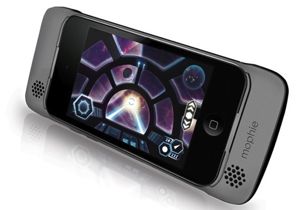A little something to expect in the next generation of video games
In video gaming, there have been two separate types of interfaces that have dominated…for mobile gaming, it's been touchscreens, and on consoles it's been 3D motion control.
Following the explosive popularity of Nintendo's Wii, the current generation of consoles all embraced air interfaces where the user becomes the controller. PlayStation Move, and especially the brilliant Microsoft Kinect take free-space motion control to new levels. And following the explosive popularity of video gaming on the iPod touch, iPad, and iPhone, many game companies have shifted to a "mobile first" attitude.
Apple's iOS has captured the hearts of the tech averse and the minds of entrepreneurs, while Microsoft's Kinect and similar "3D space interfaces" have captured the imaginations of visionaries and innovators.
But an evolution taking place just behind the interface might help push one out in front of the other.
I'm talking about "rumble."
What the hell, Tim? RUMBLE? Are you serious?
Yes, "rumble" is kind of a sad and dated low-tech term for a dumb vibrating motor that has found its way into nearly every mobile handset and tablet and is a standard feature of video game controllers. But a more respectable and sophisticated term for it would be "haptic feedback," and as it improves, it's going to improve touch-based interfaces.
Recently, researchers at Disney came forward and said they are working on a more precise vibration technology for more "touchy" movies and games, and iPhone accessory maker Mophie will soon be releasing a new vibration pack called Mophie Pulse that uses a new type of vibrator that is thinner, lighter, 70% more energy efficient than a phone's standard vibration motor, and is capable of producing a much wider variety of "feels" than the traditional on/off "buzz." Think of it as the difference between mono and stereo but for the sense of touch instead of hearing.

With the ability to create more diverse tactile sensations, developers can make the touch-based experience more informative and more useful.
Users of in-car navigation systems could, for example, have to look at the screen less and be able to locate on-screen buttons by sense of touch, or visually impaired users could be able to utilize dynamic buttons on a touchscreen device. But much of the interest of improved vibration is in improving the rumble in games, thanks in large part to the massive growth of smartphone and tablet-based gaming.
Commercial interest in that area is "extraordinary," Dirk Schapeler, CEO of Vivitouch told us this week. His company is responsible for the vibration technology that will be used in the Mophie Pulse when it's released in the coming weeks. The vibration comes from a thin film that can be mounted inside handheld devices and is capable of generating a wide variety of frequencies on many different points on the film.
"You are going to see a lot of this technology coming to market in the next couple of months," Schapeler said. "I can't disclose names, but all the big video game console companies --and especially the ones that do mobile gaming devices and applications-- are in contact with us, have our devices and technology in their hands. Some of them are more advanced in their design phase than others, but you are definitely going to see this technology in mobile gaming, and even in the next generation of consoles."
The current generation of home video game consoles all have motion controllers, and all of the current handhelds include touchscreens. The only next-gen console to be revealed thus far, Nintendo's Wii U, incorporates both touchscreens and motion controllers.
"There's a bit of a change we see coming. What the OEMs recognize is that there is a possibility in the next generation for users to touch and get more feedback," Schapeler continued. "I can't say too much, but in the next generation of consoles, the classic game controller might not look like it used to."
Schapeler's statement makes the mind wander a bit to the traditional hand controllers of the Xbox 360 and PlayStation 3. With the ability to add more nuanced vibration, each button could send a different sensation or multiple touch events could occur simultaneously. Imagine a user playing a first-person shooter, and every time he throws a grenade, he feels the explosion in his thumb, but the blast wave in his palms.
In video games, the best experiences aren't governed by any single factor like graphics or storyline or even gameplay, they're the result of the chemistry of all the elements, and sensory feedback is definitely an important element among them.
